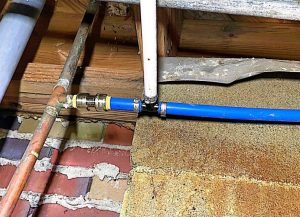 When you’re tackling a home improvement project, it’s important to make sure that the materials you use are up to the task. Whether it’s a bathroom plumbing job or a sprinkler system installation, there is much at stake if your choice of piping isn’t durable and reliable. With so many options on the market these days, choosing between PVC and PEX pipes can be overwhelming. In this blog post we’ll explore each type of pipe to better understand their key characteristics as well as analyze which option might be best for your specific needs and desired lifespan. Read on for an in-depth comparison between PVC and PEX Piping!
When you’re tackling a home improvement project, it’s important to make sure that the materials you use are up to the task. Whether it’s a bathroom plumbing job or a sprinkler system installation, there is much at stake if your choice of piping isn’t durable and reliable. With so many options on the market these days, choosing between PVC and PEX pipes can be overwhelming. In this blog post we’ll explore each type of pipe to better understand their key characteristics as well as analyze which option might be best for your specific needs and desired lifespan. Read on for an in-depth comparison between PVC and PEX Piping!
Overview of PVC and PEX piping
PVC and PEX piping are two popular options for homeowners and contractors when it comes to plumbing installations. PVC, short for polyvinyl chloride, is a rigid plastic material commonly used for drain, waste, and vent (DWV) systems due to its affordable price and durability. On the other hand, PEX, or cross-linked polyethylene, is a flexible tubing that is ideal for supply lines, as it can easily bend around obstacles and reduce the risk of leaks. Both materials have their advantages and disadvantages, and the choice ultimately depends on the specific needs and budget of the project. However, with proper installation and regular maintenance, both PVC and PEX can provide reliable and long-lasting piping solutions for various plumbing applications.
Comparison of Longevity, Sustainability, and Cost of PVC and PEX Piping
When it comes to choosing piping materials, many factors come into play, such as longevity, sustainability, and cost. PVC and PEX are two of the most popular thermoplastic pipes out there. As far as lifespan, PEX usually lasts about 40-50 years, while PVC can last about 70 years. PVC boasts impressive durability, making it perfect for use in water systems. Meanwhile, PEX is known for its flexibility and easier installation. However, it’s also essential to weigh the environmental impact of these materials. PVC presents potential health hazards due to its release of toxic chemicals during production. As for PEX, it’s touted as a more eco-friendly alternative due to its recyclability, improved energy efficiency, and fewer emissions. Finally, let’s not forget cost-effectiveness. PVC is generally cheaper than PEX, but bear in mind that affordability shouldn’t be the sole deciding factor. Before making a decision, be sure to evaluate all aspects of each piping material.
In conclusion, PVC and PEX pipes are two of the most popular types of piping on the market. When it comes to choosing between them, it really depends on the individual’s unique needs and budget. PVC is a durable, long-lasting material with a lower cost-per-foot but no flexibility, while PEX is more expensive per foot, but offers great insulation, flexibility, and is more sustainable in the long run. Although you cannot go wrong with either type of pipe for short plumbing projects such as sink hookups or drain pipes in bathrooms, PEX might be best for complicated ones like re-piping an entire home or building due to its flexibility. Furthermore, there are also many alternative pipes available that can meet anyone’s project needs. Ultimately it is important to weigh up all of your options before making a decision about which pipe to choose for your job.

